Arden University BUS6002: Strategic Management of Twitter Case Study
VerifiedAdded on 2023/01/09
|16
|4883
|37
Report
AI Summary
This report provides a detailed strategic management analysis of Twitter, a prominent microblogging and social networking platform. It begins with an introduction to strategic management principles and then delves into Twitter's operations, including its strategy formulation approach, which combines emergent and deliberate strategies. The report analyzes the importance of strategic management for major players in the social networking sector and examines Twitter's competitive environment using Porter's Five Forces model, highlighting the intense competition and the high bargaining power of customers. The VRIO framework is applied to assess Twitter's strategic capabilities. The report further analyzes Twitter's current strategies and proposes alternative future strategies based on strategic frameworks, justifying the chosen alternative using the SAF strategic model. The analysis covers Twitter's financial performance, competitive advantages, and potential future directions, offering insights into its strategic management practices within the dynamic social media landscape. The report concludes with a summary of key findings and recommendations for Twitter's strategic development.
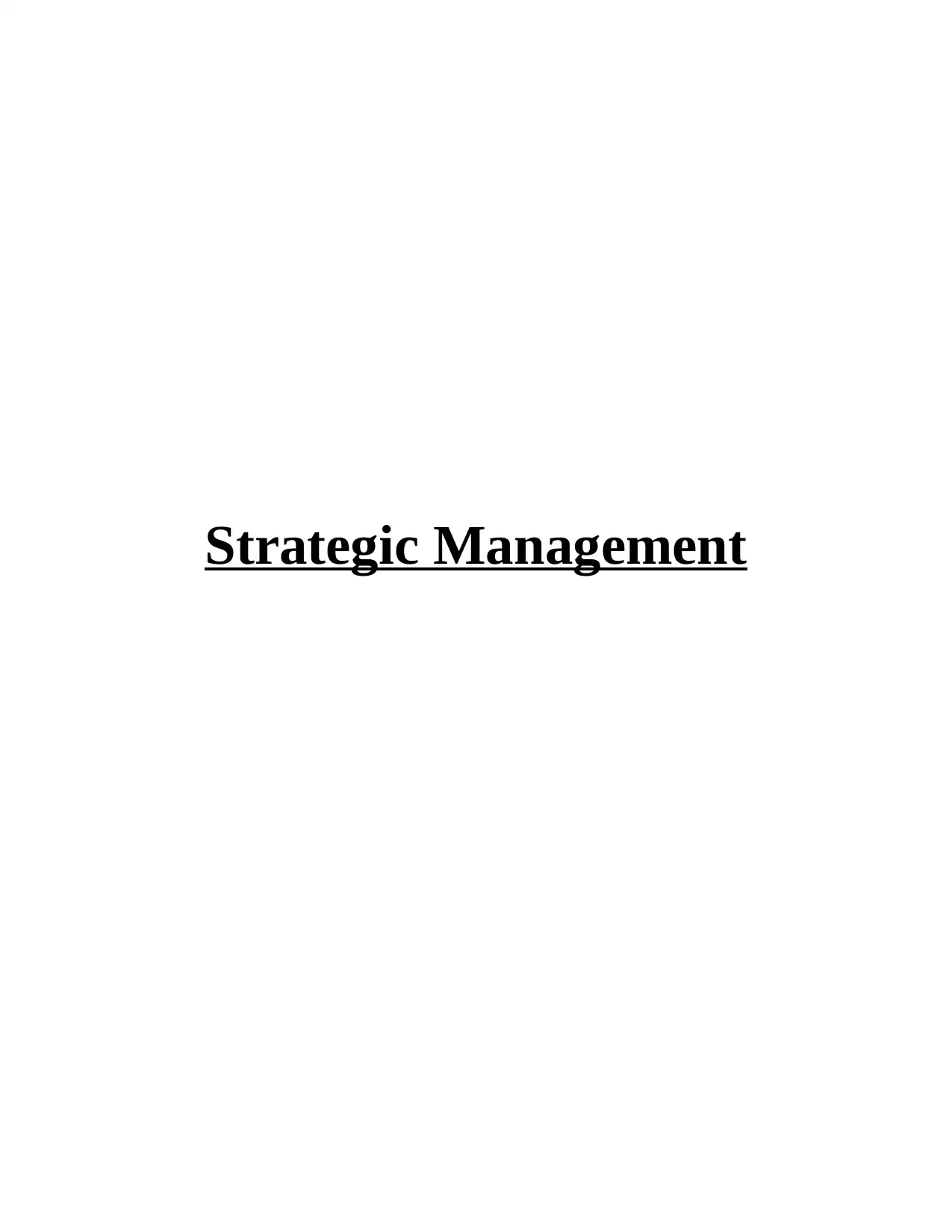
Strategic Management
Paraphrase This Document
Need a fresh take? Get an instant paraphrase of this document with our AI Paraphraser
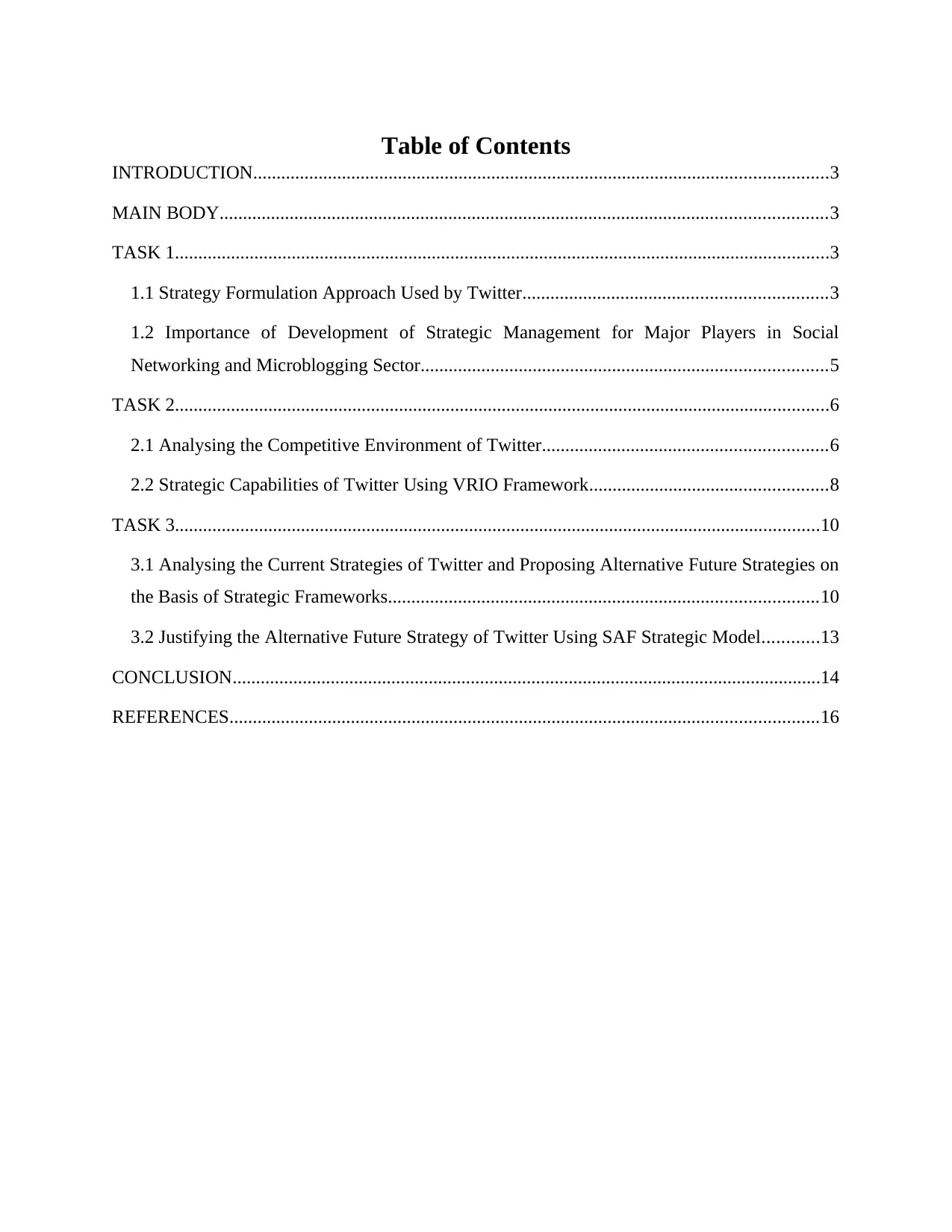
Table of Contents
INTRODUCTION...........................................................................................................................3
MAIN BODY..................................................................................................................................3
TASK 1............................................................................................................................................3
1.1 Strategy Formulation Approach Used by Twitter.................................................................3
1.2 Importance of Development of Strategic Management for Major Players in Social
Networking and Microblogging Sector.......................................................................................5
TASK 2............................................................................................................................................6
2.1 Analysing the Competitive Environment of Twitter.............................................................6
2.2 Strategic Capabilities of Twitter Using VRIO Framework...................................................8
TASK 3..........................................................................................................................................10
3.1 Analysing the Current Strategies of Twitter and Proposing Alternative Future Strategies on
the Basis of Strategic Frameworks............................................................................................10
3.2 Justifying the Alternative Future Strategy of Twitter Using SAF Strategic Model............13
CONCLUSION..............................................................................................................................14
REFERENCES..............................................................................................................................16
INTRODUCTION...........................................................................................................................3
MAIN BODY..................................................................................................................................3
TASK 1............................................................................................................................................3
1.1 Strategy Formulation Approach Used by Twitter.................................................................3
1.2 Importance of Development of Strategic Management for Major Players in Social
Networking and Microblogging Sector.......................................................................................5
TASK 2............................................................................................................................................6
2.1 Analysing the Competitive Environment of Twitter.............................................................6
2.2 Strategic Capabilities of Twitter Using VRIO Framework...................................................8
TASK 3..........................................................................................................................................10
3.1 Analysing the Current Strategies of Twitter and Proposing Alternative Future Strategies on
the Basis of Strategic Frameworks............................................................................................10
3.2 Justifying the Alternative Future Strategy of Twitter Using SAF Strategic Model............13
CONCLUSION..............................................................................................................................14
REFERENCES..............................................................................................................................16
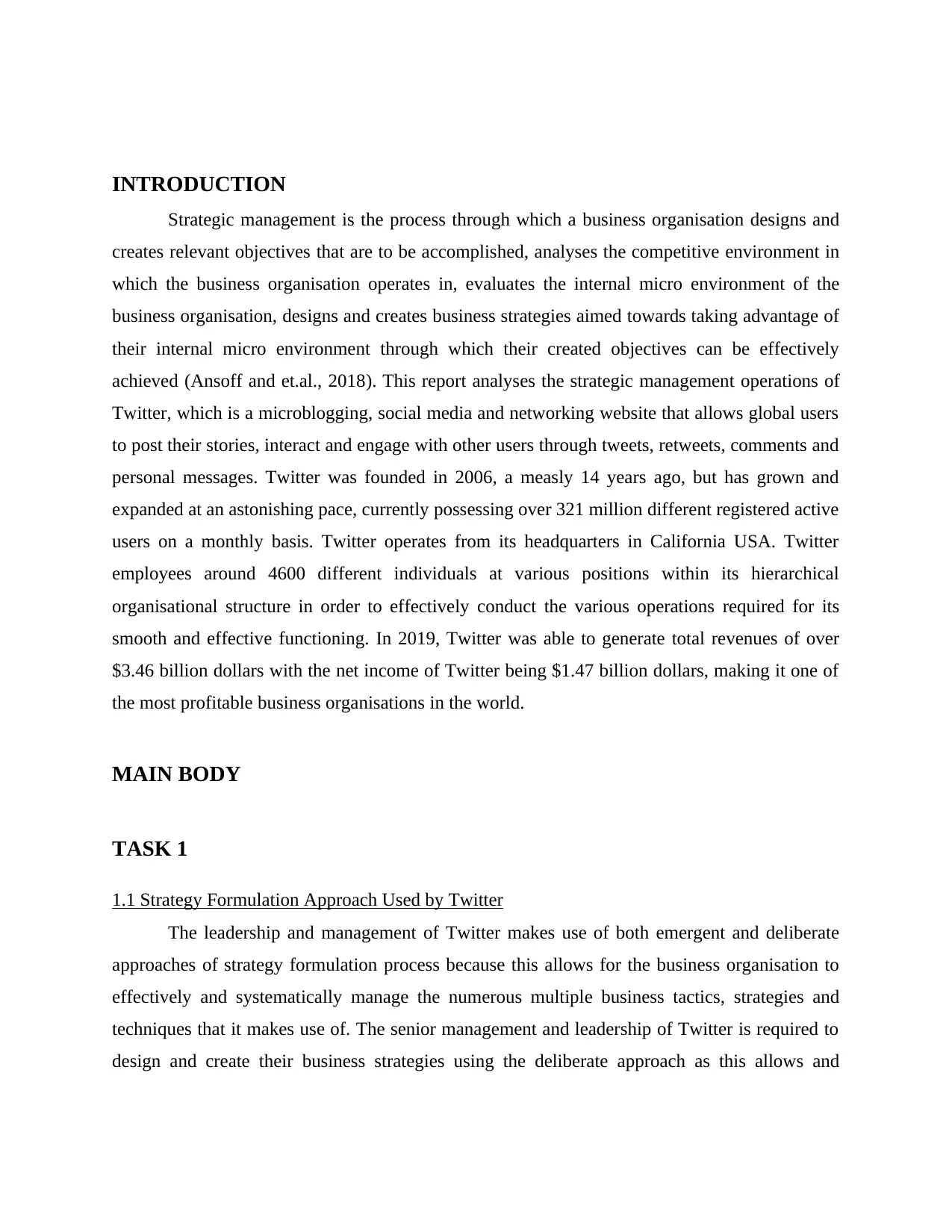
INTRODUCTION
Strategic management is the process through which a business organisation designs and
creates relevant objectives that are to be accomplished, analyses the competitive environment in
which the business organisation operates in, evaluates the internal micro environment of the
business organisation, designs and creates business strategies aimed towards taking advantage of
their internal micro environment through which their created objectives can be effectively
achieved (Ansoff and et.al., 2018). This report analyses the strategic management operations of
Twitter, which is a microblogging, social media and networking website that allows global users
to post their stories, interact and engage with other users through tweets, retweets, comments and
personal messages. Twitter was founded in 2006, a measly 14 years ago, but has grown and
expanded at an astonishing pace, currently possessing over 321 million different registered active
users on a monthly basis. Twitter operates from its headquarters in California USA. Twitter
employees around 4600 different individuals at various positions within its hierarchical
organisational structure in order to effectively conduct the various operations required for its
smooth and effective functioning. In 2019, Twitter was able to generate total revenues of over
$3.46 billion dollars with the net income of Twitter being $1.47 billion dollars, making it one of
the most profitable business organisations in the world.
MAIN BODY
TASK 1
1.1 Strategy Formulation Approach Used by Twitter
The leadership and management of Twitter makes use of both emergent and deliberate
approaches of strategy formulation process because this allows for the business organisation to
effectively and systematically manage the numerous multiple business tactics, strategies and
techniques that it makes use of. The senior management and leadership of Twitter is required to
design and create their business strategies using the deliberate approach as this allows and
Strategic management is the process through which a business organisation designs and
creates relevant objectives that are to be accomplished, analyses the competitive environment in
which the business organisation operates in, evaluates the internal micro environment of the
business organisation, designs and creates business strategies aimed towards taking advantage of
their internal micro environment through which their created objectives can be effectively
achieved (Ansoff and et.al., 2018). This report analyses the strategic management operations of
Twitter, which is a microblogging, social media and networking website that allows global users
to post their stories, interact and engage with other users through tweets, retweets, comments and
personal messages. Twitter was founded in 2006, a measly 14 years ago, but has grown and
expanded at an astonishing pace, currently possessing over 321 million different registered active
users on a monthly basis. Twitter operates from its headquarters in California USA. Twitter
employees around 4600 different individuals at various positions within its hierarchical
organisational structure in order to effectively conduct the various operations required for its
smooth and effective functioning. In 2019, Twitter was able to generate total revenues of over
$3.46 billion dollars with the net income of Twitter being $1.47 billion dollars, making it one of
the most profitable business organisations in the world.
MAIN BODY
TASK 1
1.1 Strategy Formulation Approach Used by Twitter
The leadership and management of Twitter makes use of both emergent and deliberate
approaches of strategy formulation process because this allows for the business organisation to
effectively and systematically manage the numerous multiple business tactics, strategies and
techniques that it makes use of. The senior management and leadership of Twitter is required to
design and create their business strategies using the deliberate approach as this allows and
⊘ This is a preview!⊘
Do you want full access?
Subscribe today to unlock all pages.

Trusted by 1+ million students worldwide
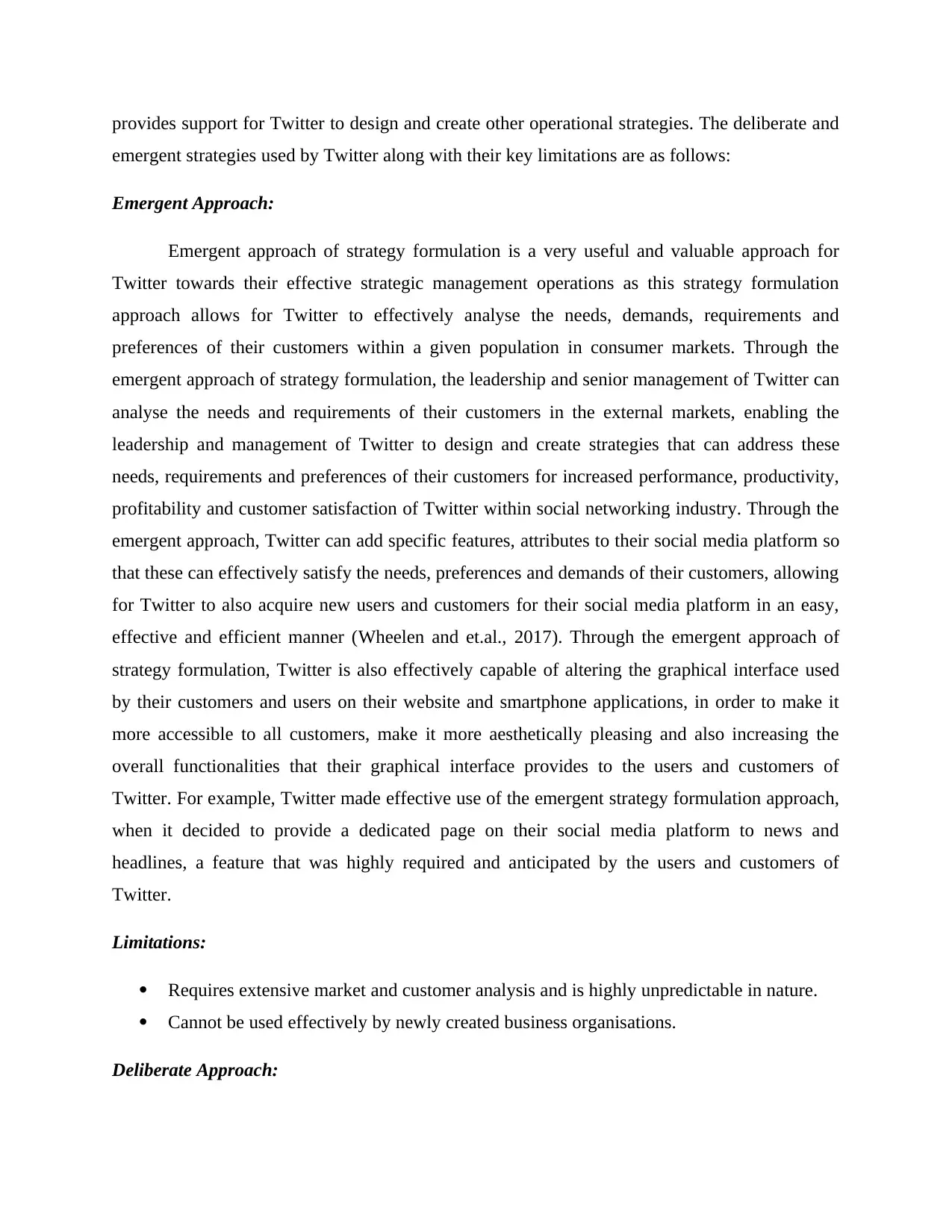
provides support for Twitter to design and create other operational strategies. The deliberate and
emergent strategies used by Twitter along with their key limitations are as follows:
Emergent Approach:
Emergent approach of strategy formulation is a very useful and valuable approach for
Twitter towards their effective strategic management operations as this strategy formulation
approach allows for Twitter to effectively analyse the needs, demands, requirements and
preferences of their customers within a given population in consumer markets. Through the
emergent approach of strategy formulation, the leadership and senior management of Twitter can
analyse the needs and requirements of their customers in the external markets, enabling the
leadership and management of Twitter to design and create strategies that can address these
needs, requirements and preferences of their customers for increased performance, productivity,
profitability and customer satisfaction of Twitter within social networking industry. Through the
emergent approach, Twitter can add specific features, attributes to their social media platform so
that these can effectively satisfy the needs, preferences and demands of their customers, allowing
for Twitter to also acquire new users and customers for their social media platform in an easy,
effective and efficient manner (Wheelen and et.al., 2017). Through the emergent approach of
strategy formulation, Twitter is also effectively capable of altering the graphical interface used
by their customers and users on their website and smartphone applications, in order to make it
more accessible to all customers, make it more aesthetically pleasing and also increasing the
overall functionalities that their graphical interface provides to the users and customers of
Twitter. For example, Twitter made effective use of the emergent strategy formulation approach,
when it decided to provide a dedicated page on their social media platform to news and
headlines, a feature that was highly required and anticipated by the users and customers of
Twitter.
Limitations:
Requires extensive market and customer analysis and is highly unpredictable in nature.
Cannot be used effectively by newly created business organisations.
Deliberate Approach:
emergent strategies used by Twitter along with their key limitations are as follows:
Emergent Approach:
Emergent approach of strategy formulation is a very useful and valuable approach for
Twitter towards their effective strategic management operations as this strategy formulation
approach allows for Twitter to effectively analyse the needs, demands, requirements and
preferences of their customers within a given population in consumer markets. Through the
emergent approach of strategy formulation, the leadership and senior management of Twitter can
analyse the needs and requirements of their customers in the external markets, enabling the
leadership and management of Twitter to design and create strategies that can address these
needs, requirements and preferences of their customers for increased performance, productivity,
profitability and customer satisfaction of Twitter within social networking industry. Through the
emergent approach, Twitter can add specific features, attributes to their social media platform so
that these can effectively satisfy the needs, preferences and demands of their customers, allowing
for Twitter to also acquire new users and customers for their social media platform in an easy,
effective and efficient manner (Wheelen and et.al., 2017). Through the emergent approach of
strategy formulation, Twitter is also effectively capable of altering the graphical interface used
by their customers and users on their website and smartphone applications, in order to make it
more accessible to all customers, make it more aesthetically pleasing and also increasing the
overall functionalities that their graphical interface provides to the users and customers of
Twitter. For example, Twitter made effective use of the emergent strategy formulation approach,
when it decided to provide a dedicated page on their social media platform to news and
headlines, a feature that was highly required and anticipated by the users and customers of
Twitter.
Limitations:
Requires extensive market and customer analysis and is highly unpredictable in nature.
Cannot be used effectively by newly created business organisations.
Deliberate Approach:
Paraphrase This Document
Need a fresh take? Get an instant paraphrase of this document with our AI Paraphraser
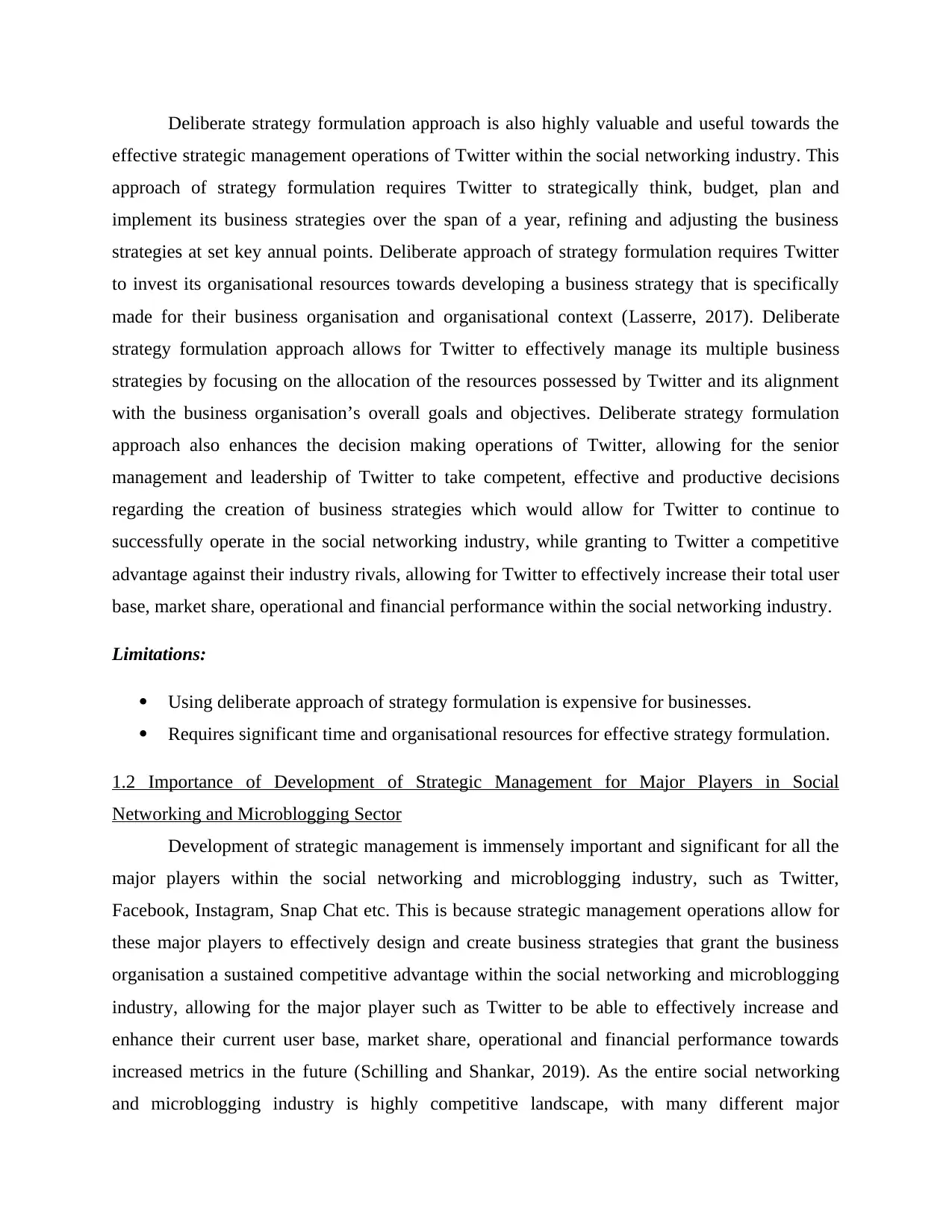
Deliberate strategy formulation approach is also highly valuable and useful towards the
effective strategic management operations of Twitter within the social networking industry. This
approach of strategy formulation requires Twitter to strategically think, budget, plan and
implement its business strategies over the span of a year, refining and adjusting the business
strategies at set key annual points. Deliberate approach of strategy formulation requires Twitter
to invest its organisational resources towards developing a business strategy that is specifically
made for their business organisation and organisational context (Lasserre, 2017). Deliberate
strategy formulation approach allows for Twitter to effectively manage its multiple business
strategies by focusing on the allocation of the resources possessed by Twitter and its alignment
with the business organisation’s overall goals and objectives. Deliberate strategy formulation
approach also enhances the decision making operations of Twitter, allowing for the senior
management and leadership of Twitter to take competent, effective and productive decisions
regarding the creation of business strategies which would allow for Twitter to continue to
successfully operate in the social networking industry, while granting to Twitter a competitive
advantage against their industry rivals, allowing for Twitter to effectively increase their total user
base, market share, operational and financial performance within the social networking industry.
Limitations:
Using deliberate approach of strategy formulation is expensive for businesses.
Requires significant time and organisational resources for effective strategy formulation.
1.2 Importance of Development of Strategic Management for Major Players in Social
Networking and Microblogging Sector
Development of strategic management is immensely important and significant for all the
major players within the social networking and microblogging industry, such as Twitter,
Facebook, Instagram, Snap Chat etc. This is because strategic management operations allow for
these major players to effectively design and create business strategies that grant the business
organisation a sustained competitive advantage within the social networking and microblogging
industry, allowing for the major player such as Twitter to be able to effectively increase and
enhance their current user base, market share, operational and financial performance towards
increased metrics in the future (Schilling and Shankar, 2019). As the entire social networking
and microblogging industry is highly competitive landscape, with many different major
effective strategic management operations of Twitter within the social networking industry. This
approach of strategy formulation requires Twitter to strategically think, budget, plan and
implement its business strategies over the span of a year, refining and adjusting the business
strategies at set key annual points. Deliberate approach of strategy formulation requires Twitter
to invest its organisational resources towards developing a business strategy that is specifically
made for their business organisation and organisational context (Lasserre, 2017). Deliberate
strategy formulation approach allows for Twitter to effectively manage its multiple business
strategies by focusing on the allocation of the resources possessed by Twitter and its alignment
with the business organisation’s overall goals and objectives. Deliberate strategy formulation
approach also enhances the decision making operations of Twitter, allowing for the senior
management and leadership of Twitter to take competent, effective and productive decisions
regarding the creation of business strategies which would allow for Twitter to continue to
successfully operate in the social networking industry, while granting to Twitter a competitive
advantage against their industry rivals, allowing for Twitter to effectively increase their total user
base, market share, operational and financial performance within the social networking industry.
Limitations:
Using deliberate approach of strategy formulation is expensive for businesses.
Requires significant time and organisational resources for effective strategy formulation.
1.2 Importance of Development of Strategic Management for Major Players in Social
Networking and Microblogging Sector
Development of strategic management is immensely important and significant for all the
major players within the social networking and microblogging industry, such as Twitter,
Facebook, Instagram, Snap Chat etc. This is because strategic management operations allow for
these major players to effectively design and create business strategies that grant the business
organisation a sustained competitive advantage within the social networking and microblogging
industry, allowing for the major player such as Twitter to be able to effectively increase and
enhance their current user base, market share, operational and financial performance towards
increased metrics in the future (Schilling and Shankar, 2019). As the entire social networking
and microblogging industry is highly competitive landscape, with many different major
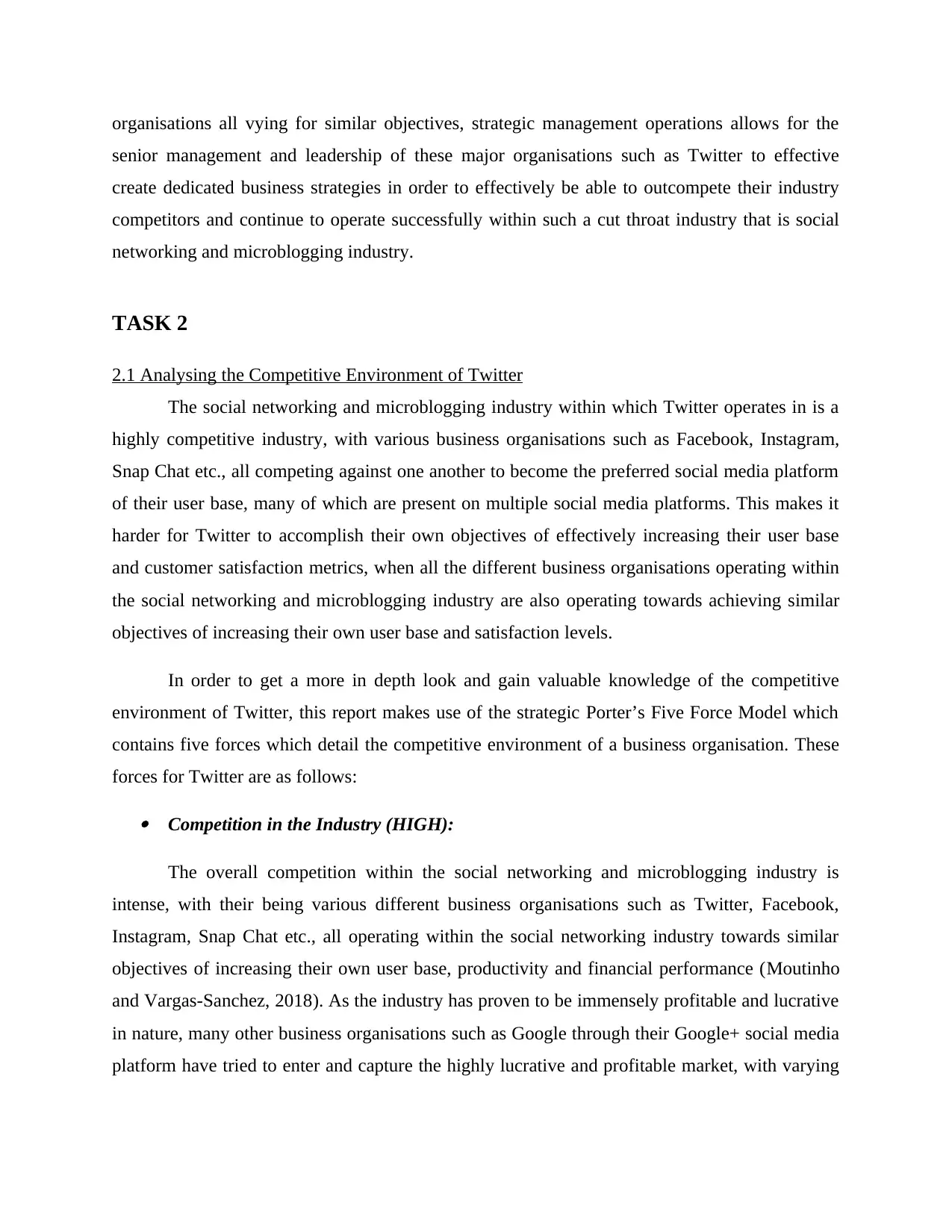
organisations all vying for similar objectives, strategic management operations allows for the
senior management and leadership of these major organisations such as Twitter to effective
create dedicated business strategies in order to effectively be able to outcompete their industry
competitors and continue to operate successfully within such a cut throat industry that is social
networking and microblogging industry.
TASK 2
2.1 Analysing the Competitive Environment of Twitter
The social networking and microblogging industry within which Twitter operates in is a
highly competitive industry, with various business organisations such as Facebook, Instagram,
Snap Chat etc., all competing against one another to become the preferred social media platform
of their user base, many of which are present on multiple social media platforms. This makes it
harder for Twitter to accomplish their own objectives of effectively increasing their user base
and customer satisfaction metrics, when all the different business organisations operating within
the social networking and microblogging industry are also operating towards achieving similar
objectives of increasing their own user base and satisfaction levels.
In order to get a more in depth look and gain valuable knowledge of the competitive
environment of Twitter, this report makes use of the strategic Porter’s Five Force Model which
contains five forces which detail the competitive environment of a business organisation. These
forces for Twitter are as follows:
Competition in the Industry (HIGH):
The overall competition within the social networking and microblogging industry is
intense, with their being various different business organisations such as Twitter, Facebook,
Instagram, Snap Chat etc., all operating within the social networking industry towards similar
objectives of increasing their own user base, productivity and financial performance (Moutinho
and Vargas-Sanchez, 2018). As the industry has proven to be immensely profitable and lucrative
in nature, many other business organisations such as Google through their Google+ social media
platform have tried to enter and capture the highly lucrative and profitable market, with varying
senior management and leadership of these major organisations such as Twitter to effective
create dedicated business strategies in order to effectively be able to outcompete their industry
competitors and continue to operate successfully within such a cut throat industry that is social
networking and microblogging industry.
TASK 2
2.1 Analysing the Competitive Environment of Twitter
The social networking and microblogging industry within which Twitter operates in is a
highly competitive industry, with various business organisations such as Facebook, Instagram,
Snap Chat etc., all competing against one another to become the preferred social media platform
of their user base, many of which are present on multiple social media platforms. This makes it
harder for Twitter to accomplish their own objectives of effectively increasing their user base
and customer satisfaction metrics, when all the different business organisations operating within
the social networking and microblogging industry are also operating towards achieving similar
objectives of increasing their own user base and satisfaction levels.
In order to get a more in depth look and gain valuable knowledge of the competitive
environment of Twitter, this report makes use of the strategic Porter’s Five Force Model which
contains five forces which detail the competitive environment of a business organisation. These
forces for Twitter are as follows:
Competition in the Industry (HIGH):
The overall competition within the social networking and microblogging industry is
intense, with their being various different business organisations such as Twitter, Facebook,
Instagram, Snap Chat etc., all operating within the social networking industry towards similar
objectives of increasing their own user base, productivity and financial performance (Moutinho
and Vargas-Sanchez, 2018). As the industry has proven to be immensely profitable and lucrative
in nature, many other business organisations such as Google through their Google+ social media
platform have tried to enter and capture the highly lucrative and profitable market, with varying
⊘ This is a preview!⊘
Do you want full access?
Subscribe today to unlock all pages.

Trusted by 1+ million students worldwide
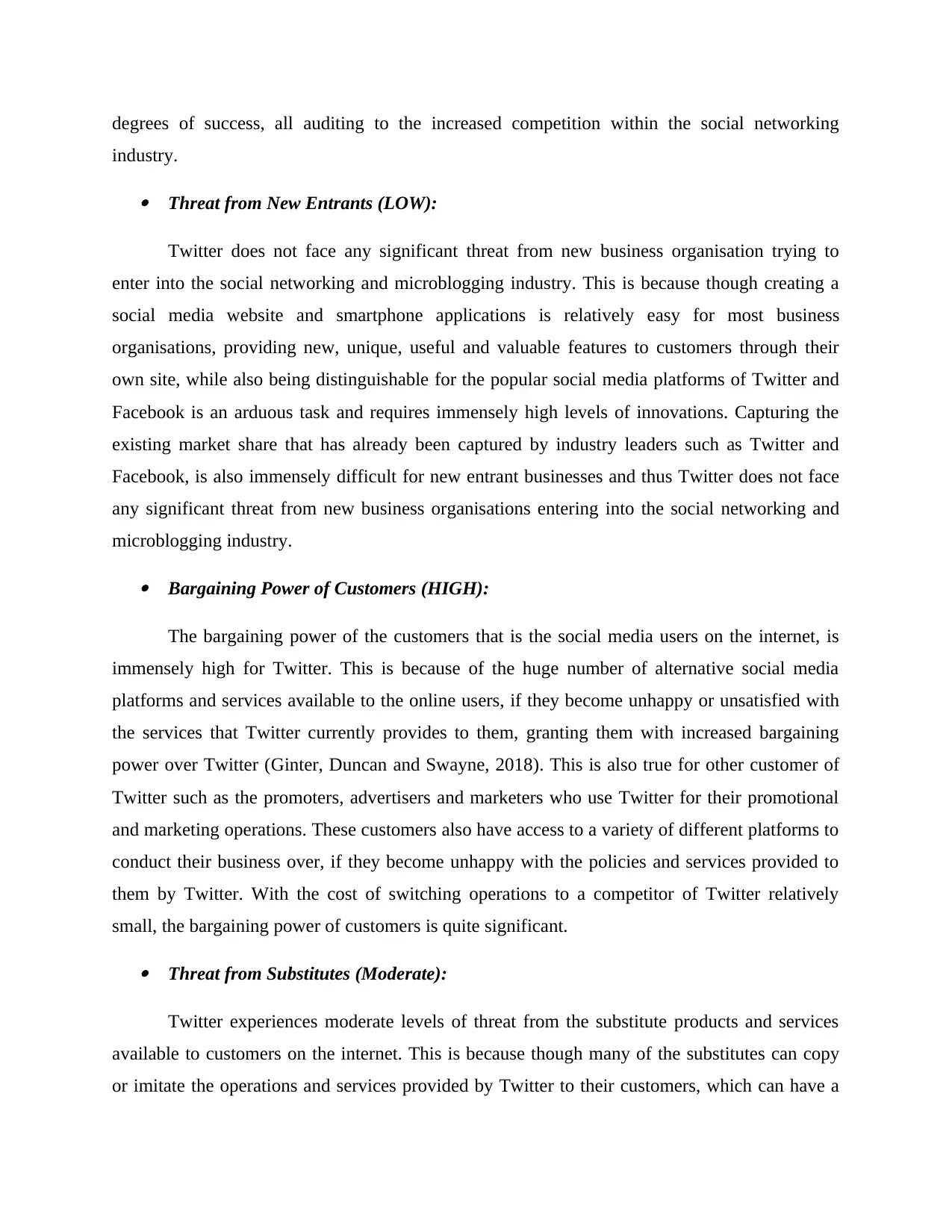
degrees of success, all auditing to the increased competition within the social networking
industry.
Threat from New Entrants (LOW):
Twitter does not face any significant threat from new business organisation trying to
enter into the social networking and microblogging industry. This is because though creating a
social media website and smartphone applications is relatively easy for most business
organisations, providing new, unique, useful and valuable features to customers through their
own site, while also being distinguishable for the popular social media platforms of Twitter and
Facebook is an arduous task and requires immensely high levels of innovations. Capturing the
existing market share that has already been captured by industry leaders such as Twitter and
Facebook, is also immensely difficult for new entrant businesses and thus Twitter does not face
any significant threat from new business organisations entering into the social networking and
microblogging industry.
Bargaining Power of Customers (HIGH):
The bargaining power of the customers that is the social media users on the internet, is
immensely high for Twitter. This is because of the huge number of alternative social media
platforms and services available to the online users, if they become unhappy or unsatisfied with
the services that Twitter currently provides to them, granting them with increased bargaining
power over Twitter (Ginter, Duncan and Swayne, 2018). This is also true for other customer of
Twitter such as the promoters, advertisers and marketers who use Twitter for their promotional
and marketing operations. These customers also have access to a variety of different platforms to
conduct their business over, if they become unhappy with the policies and services provided to
them by Twitter. With the cost of switching operations to a competitor of Twitter relatively
small, the bargaining power of customers is quite significant.
Threat from Substitutes (Moderate):
Twitter experiences moderate levels of threat from the substitute products and services
available to customers on the internet. This is because though many of the substitutes can copy
or imitate the operations and services provided by Twitter to their customers, which can have a
industry.
Threat from New Entrants (LOW):
Twitter does not face any significant threat from new business organisation trying to
enter into the social networking and microblogging industry. This is because though creating a
social media website and smartphone applications is relatively easy for most business
organisations, providing new, unique, useful and valuable features to customers through their
own site, while also being distinguishable for the popular social media platforms of Twitter and
Facebook is an arduous task and requires immensely high levels of innovations. Capturing the
existing market share that has already been captured by industry leaders such as Twitter and
Facebook, is also immensely difficult for new entrant businesses and thus Twitter does not face
any significant threat from new business organisations entering into the social networking and
microblogging industry.
Bargaining Power of Customers (HIGH):
The bargaining power of the customers that is the social media users on the internet, is
immensely high for Twitter. This is because of the huge number of alternative social media
platforms and services available to the online users, if they become unhappy or unsatisfied with
the services that Twitter currently provides to them, granting them with increased bargaining
power over Twitter (Ginter, Duncan and Swayne, 2018). This is also true for other customer of
Twitter such as the promoters, advertisers and marketers who use Twitter for their promotional
and marketing operations. These customers also have access to a variety of different platforms to
conduct their business over, if they become unhappy with the policies and services provided to
them by Twitter. With the cost of switching operations to a competitor of Twitter relatively
small, the bargaining power of customers is quite significant.
Threat from Substitutes (Moderate):
Twitter experiences moderate levels of threat from the substitute products and services
available to customers on the internet. This is because though many of the substitutes can copy
or imitate the operations and services provided by Twitter to their customers, which can have a
Paraphrase This Document
Need a fresh take? Get an instant paraphrase of this document with our AI Paraphraser
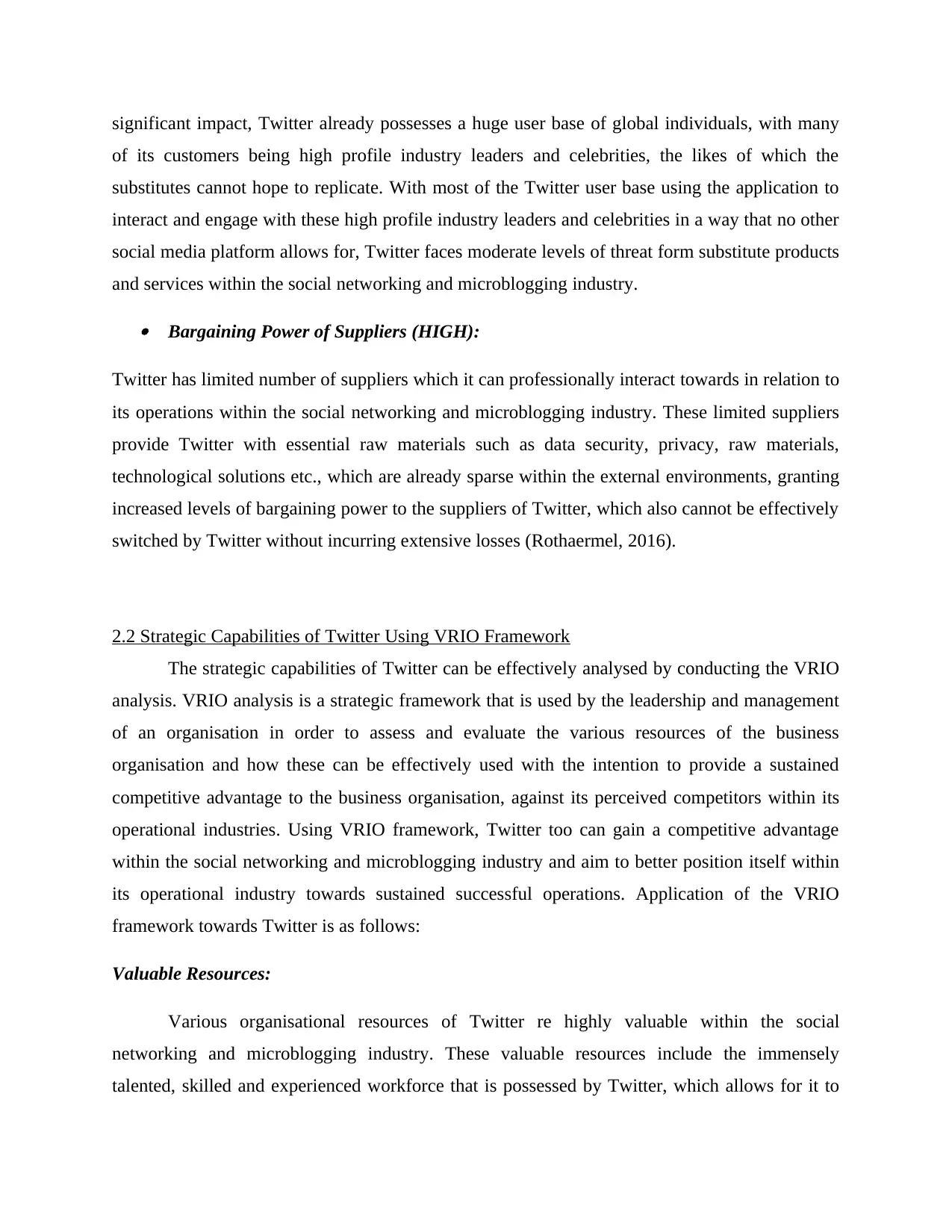
significant impact, Twitter already possesses a huge user base of global individuals, with many
of its customers being high profile industry leaders and celebrities, the likes of which the
substitutes cannot hope to replicate. With most of the Twitter user base using the application to
interact and engage with these high profile industry leaders and celebrities in a way that no other
social media platform allows for, Twitter faces moderate levels of threat form substitute products
and services within the social networking and microblogging industry.
Bargaining Power of Suppliers (HIGH):
Twitter has limited number of suppliers which it can professionally interact towards in relation to
its operations within the social networking and microblogging industry. These limited suppliers
provide Twitter with essential raw materials such as data security, privacy, raw materials,
technological solutions etc., which are already sparse within the external environments, granting
increased levels of bargaining power to the suppliers of Twitter, which also cannot be effectively
switched by Twitter without incurring extensive losses (Rothaermel, 2016).
2.2 Strategic Capabilities of Twitter Using VRIO Framework
The strategic capabilities of Twitter can be effectively analysed by conducting the VRIO
analysis. VRIO analysis is a strategic framework that is used by the leadership and management
of an organisation in order to assess and evaluate the various resources of the business
organisation and how these can be effectively used with the intention to provide a sustained
competitive advantage to the business organisation, against its perceived competitors within its
operational industries. Using VRIO framework, Twitter too can gain a competitive advantage
within the social networking and microblogging industry and aim to better position itself within
its operational industry towards sustained successful operations. Application of the VRIO
framework towards Twitter is as follows:
Valuable Resources:
Various organisational resources of Twitter re highly valuable within the social
networking and microblogging industry. These valuable resources include the immensely
talented, skilled and experienced workforce that is possessed by Twitter, which allows for it to
of its customers being high profile industry leaders and celebrities, the likes of which the
substitutes cannot hope to replicate. With most of the Twitter user base using the application to
interact and engage with these high profile industry leaders and celebrities in a way that no other
social media platform allows for, Twitter faces moderate levels of threat form substitute products
and services within the social networking and microblogging industry.
Bargaining Power of Suppliers (HIGH):
Twitter has limited number of suppliers which it can professionally interact towards in relation to
its operations within the social networking and microblogging industry. These limited suppliers
provide Twitter with essential raw materials such as data security, privacy, raw materials,
technological solutions etc., which are already sparse within the external environments, granting
increased levels of bargaining power to the suppliers of Twitter, which also cannot be effectively
switched by Twitter without incurring extensive losses (Rothaermel, 2016).
2.2 Strategic Capabilities of Twitter Using VRIO Framework
The strategic capabilities of Twitter can be effectively analysed by conducting the VRIO
analysis. VRIO analysis is a strategic framework that is used by the leadership and management
of an organisation in order to assess and evaluate the various resources of the business
organisation and how these can be effectively used with the intention to provide a sustained
competitive advantage to the business organisation, against its perceived competitors within its
operational industries. Using VRIO framework, Twitter too can gain a competitive advantage
within the social networking and microblogging industry and aim to better position itself within
its operational industry towards sustained successful operations. Application of the VRIO
framework towards Twitter is as follows:
Valuable Resources:
Various organisational resources of Twitter re highly valuable within the social
networking and microblogging industry. These valuable resources include the immensely
talented, skilled and experienced workforce that is possessed by Twitter, which allows for it to
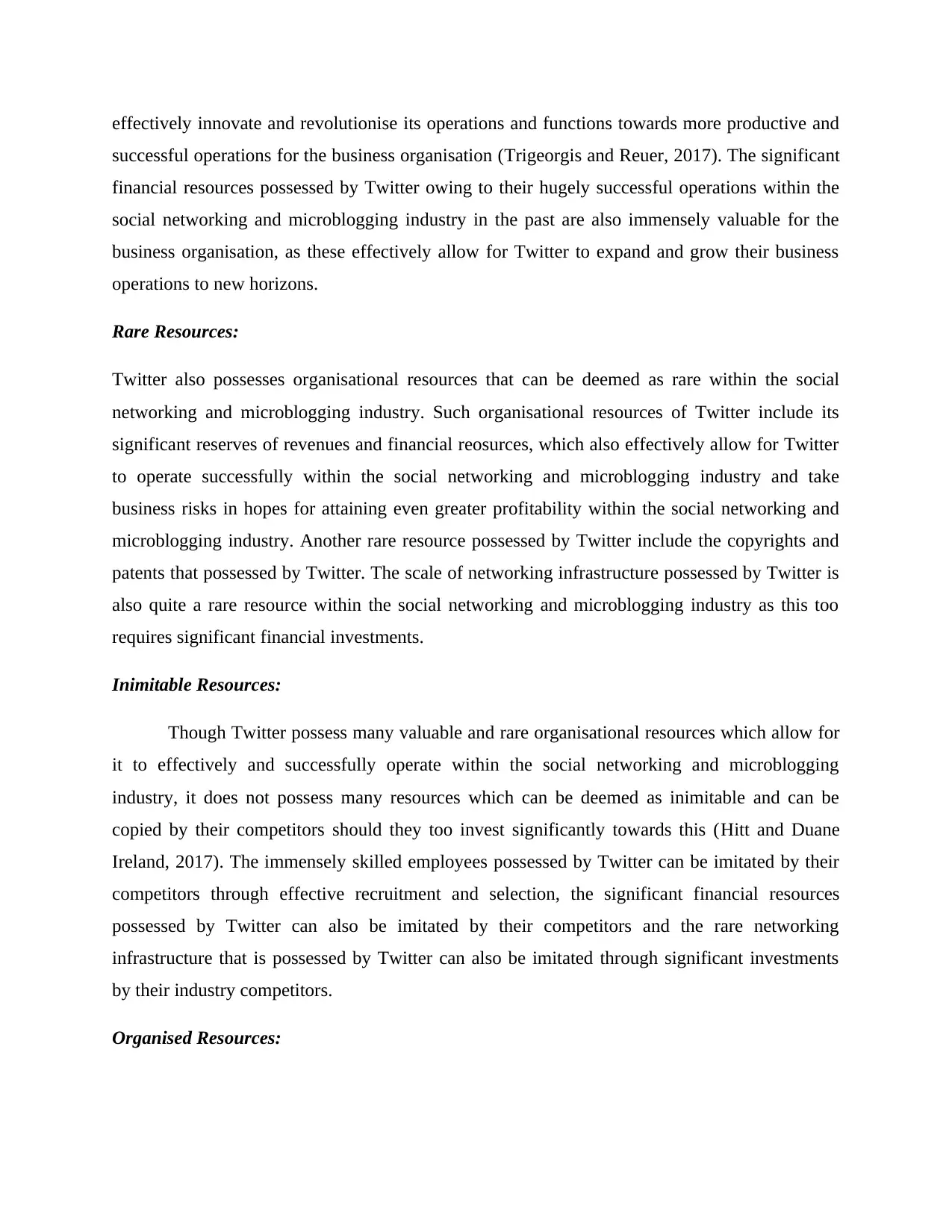
effectively innovate and revolutionise its operations and functions towards more productive and
successful operations for the business organisation (Trigeorgis and Reuer, 2017). The significant
financial resources possessed by Twitter owing to their hugely successful operations within the
social networking and microblogging industry in the past are also immensely valuable for the
business organisation, as these effectively allow for Twitter to expand and grow their business
operations to new horizons.
Rare Resources:
Twitter also possesses organisational resources that can be deemed as rare within the social
networking and microblogging industry. Such organisational resources of Twitter include its
significant reserves of revenues and financial reosurces, which also effectively allow for Twitter
to operate successfully within the social networking and microblogging industry and take
business risks in hopes for attaining even greater profitability within the social networking and
microblogging industry. Another rare resource possessed by Twitter include the copyrights and
patents that possessed by Twitter. The scale of networking infrastructure possessed by Twitter is
also quite a rare resource within the social networking and microblogging industry as this too
requires significant financial investments.
Inimitable Resources:
Though Twitter possess many valuable and rare organisational resources which allow for
it to effectively and successfully operate within the social networking and microblogging
industry, it does not possess many resources which can be deemed as inimitable and can be
copied by their competitors should they too invest significantly towards this (Hitt and Duane
Ireland, 2017). The immensely skilled employees possessed by Twitter can be imitated by their
competitors through effective recruitment and selection, the significant financial resources
possessed by Twitter can also be imitated by their competitors and the rare networking
infrastructure that is possessed by Twitter can also be imitated through significant investments
by their industry competitors.
Organised Resources:
successful operations for the business organisation (Trigeorgis and Reuer, 2017). The significant
financial resources possessed by Twitter owing to their hugely successful operations within the
social networking and microblogging industry in the past are also immensely valuable for the
business organisation, as these effectively allow for Twitter to expand and grow their business
operations to new horizons.
Rare Resources:
Twitter also possesses organisational resources that can be deemed as rare within the social
networking and microblogging industry. Such organisational resources of Twitter include its
significant reserves of revenues and financial reosurces, which also effectively allow for Twitter
to operate successfully within the social networking and microblogging industry and take
business risks in hopes for attaining even greater profitability within the social networking and
microblogging industry. Another rare resource possessed by Twitter include the copyrights and
patents that possessed by Twitter. The scale of networking infrastructure possessed by Twitter is
also quite a rare resource within the social networking and microblogging industry as this too
requires significant financial investments.
Inimitable Resources:
Though Twitter possess many valuable and rare organisational resources which allow for
it to effectively and successfully operate within the social networking and microblogging
industry, it does not possess many resources which can be deemed as inimitable and can be
copied by their competitors should they too invest significantly towards this (Hitt and Duane
Ireland, 2017). The immensely skilled employees possessed by Twitter can be imitated by their
competitors through effective recruitment and selection, the significant financial resources
possessed by Twitter can also be imitated by their competitors and the rare networking
infrastructure that is possessed by Twitter can also be imitated through significant investments
by their industry competitors.
Organised Resources:
⊘ This is a preview!⊘
Do you want full access?
Subscribe today to unlock all pages.

Trusted by 1+ million students worldwide
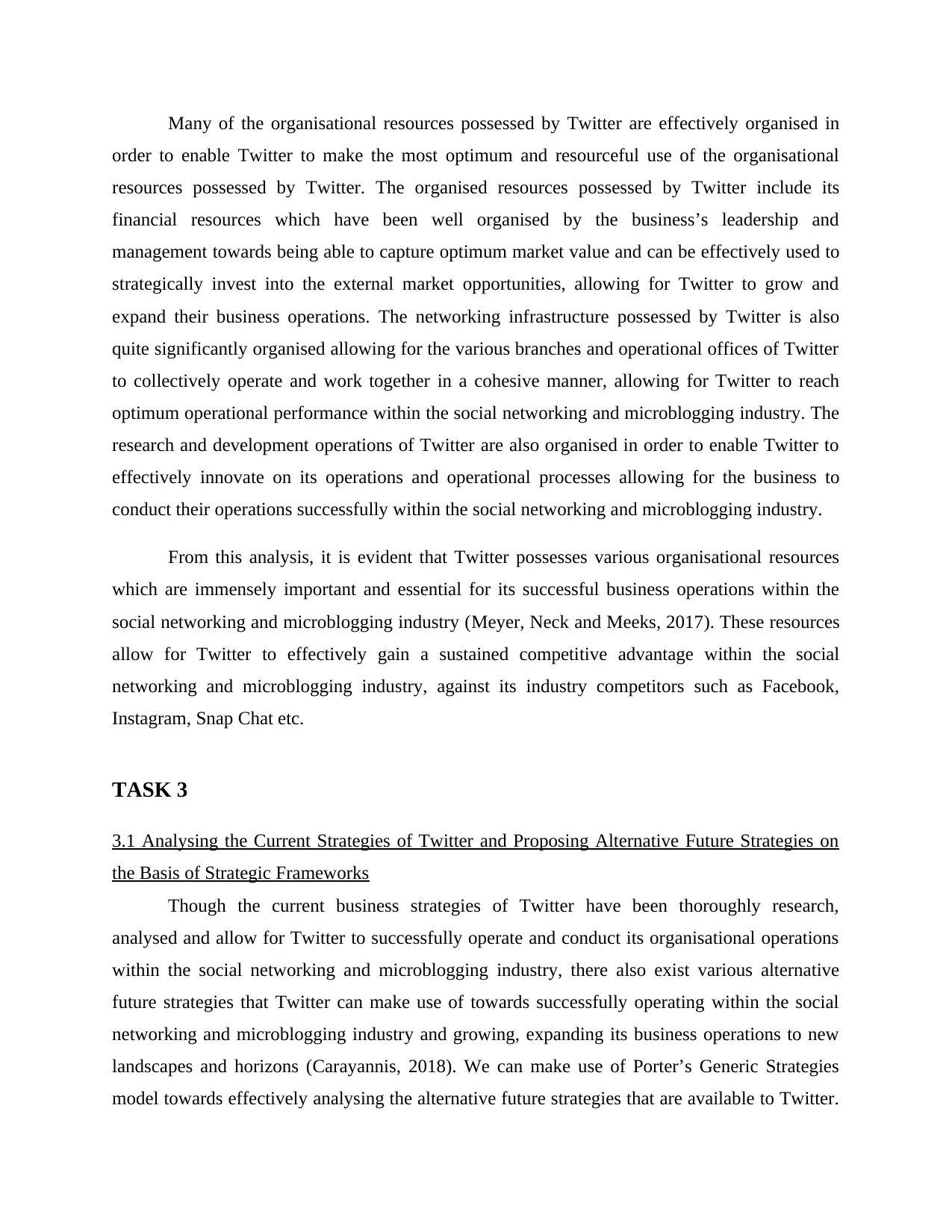
Many of the organisational resources possessed by Twitter are effectively organised in
order to enable Twitter to make the most optimum and resourceful use of the organisational
resources possessed by Twitter. The organised resources possessed by Twitter include its
financial resources which have been well organised by the business’s leadership and
management towards being able to capture optimum market value and can be effectively used to
strategically invest into the external market opportunities, allowing for Twitter to grow and
expand their business operations. The networking infrastructure possessed by Twitter is also
quite significantly organised allowing for the various branches and operational offices of Twitter
to collectively operate and work together in a cohesive manner, allowing for Twitter to reach
optimum operational performance within the social networking and microblogging industry. The
research and development operations of Twitter are also organised in order to enable Twitter to
effectively innovate on its operations and operational processes allowing for the business to
conduct their operations successfully within the social networking and microblogging industry.
From this analysis, it is evident that Twitter possesses various organisational resources
which are immensely important and essential for its successful business operations within the
social networking and microblogging industry (Meyer, Neck and Meeks, 2017). These resources
allow for Twitter to effectively gain a sustained competitive advantage within the social
networking and microblogging industry, against its industry competitors such as Facebook,
Instagram, Snap Chat etc.
TASK 3
3.1 Analysing the Current Strategies of Twitter and Proposing Alternative Future Strategies on
the Basis of Strategic Frameworks
Though the current business strategies of Twitter have been thoroughly research,
analysed and allow for Twitter to successfully operate and conduct its organisational operations
within the social networking and microblogging industry, there also exist various alternative
future strategies that Twitter can make use of towards successfully operating within the social
networking and microblogging industry and growing, expanding its business operations to new
landscapes and horizons (Carayannis, 2018). We can make use of Porter’s Generic Strategies
model towards effectively analysing the alternative future strategies that are available to Twitter.
order to enable Twitter to make the most optimum and resourceful use of the organisational
resources possessed by Twitter. The organised resources possessed by Twitter include its
financial resources which have been well organised by the business’s leadership and
management towards being able to capture optimum market value and can be effectively used to
strategically invest into the external market opportunities, allowing for Twitter to grow and
expand their business operations. The networking infrastructure possessed by Twitter is also
quite significantly organised allowing for the various branches and operational offices of Twitter
to collectively operate and work together in a cohesive manner, allowing for Twitter to reach
optimum operational performance within the social networking and microblogging industry. The
research and development operations of Twitter are also organised in order to enable Twitter to
effectively innovate on its operations and operational processes allowing for the business to
conduct their operations successfully within the social networking and microblogging industry.
From this analysis, it is evident that Twitter possesses various organisational resources
which are immensely important and essential for its successful business operations within the
social networking and microblogging industry (Meyer, Neck and Meeks, 2017). These resources
allow for Twitter to effectively gain a sustained competitive advantage within the social
networking and microblogging industry, against its industry competitors such as Facebook,
Instagram, Snap Chat etc.
TASK 3
3.1 Analysing the Current Strategies of Twitter and Proposing Alternative Future Strategies on
the Basis of Strategic Frameworks
Though the current business strategies of Twitter have been thoroughly research,
analysed and allow for Twitter to successfully operate and conduct its organisational operations
within the social networking and microblogging industry, there also exist various alternative
future strategies that Twitter can make use of towards successfully operating within the social
networking and microblogging industry and growing, expanding its business operations to new
landscapes and horizons (Carayannis, 2018). We can make use of Porter’s Generic Strategies
model towards effectively analysing the alternative future strategies that are available to Twitter.
Paraphrase This Document
Need a fresh take? Get an instant paraphrase of this document with our AI Paraphraser
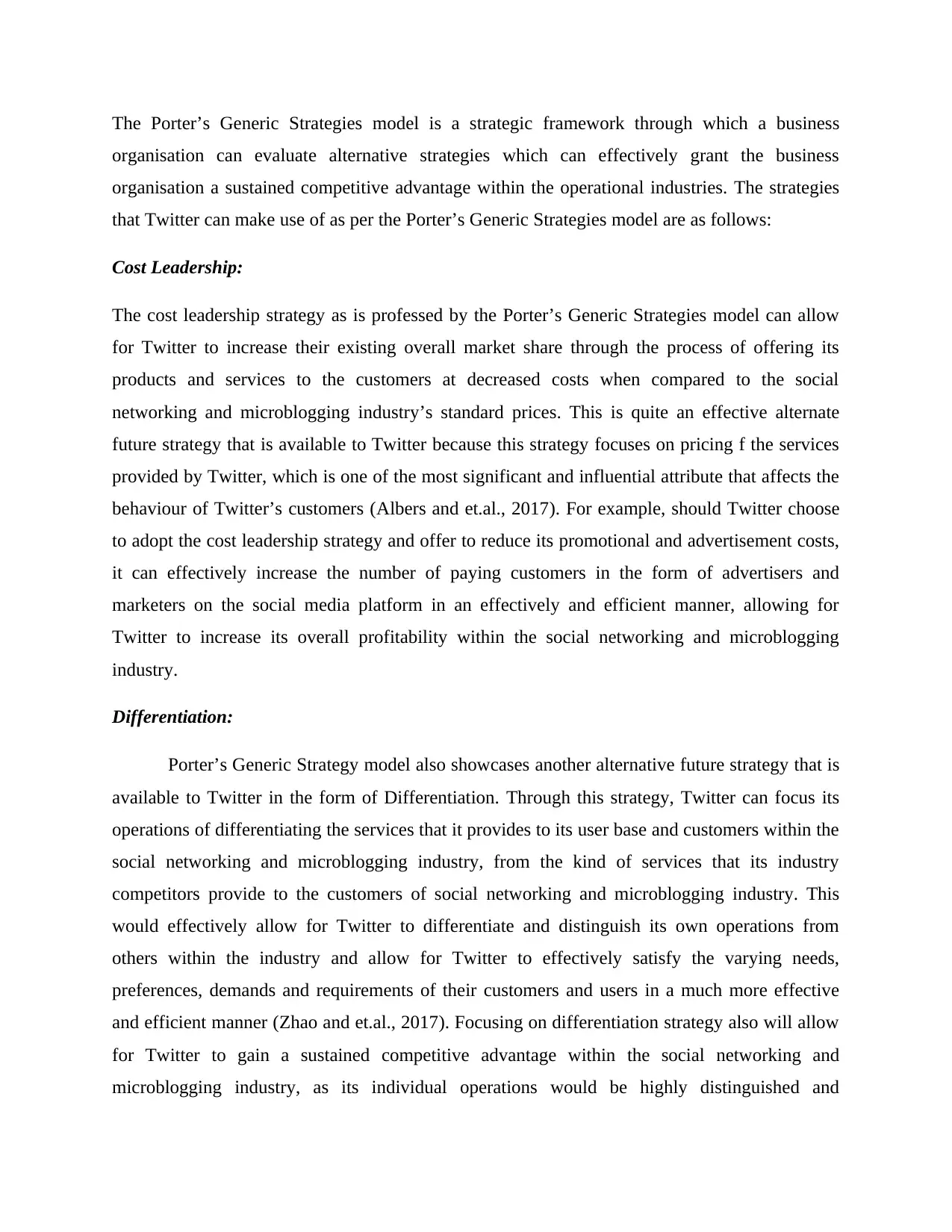
The Porter’s Generic Strategies model is a strategic framework through which a business
organisation can evaluate alternative strategies which can effectively grant the business
organisation a sustained competitive advantage within the operational industries. The strategies
that Twitter can make use of as per the Porter’s Generic Strategies model are as follows:
Cost Leadership:
The cost leadership strategy as is professed by the Porter’s Generic Strategies model can allow
for Twitter to increase their existing overall market share through the process of offering its
products and services to the customers at decreased costs when compared to the social
networking and microblogging industry’s standard prices. This is quite an effective alternate
future strategy that is available to Twitter because this strategy focuses on pricing f the services
provided by Twitter, which is one of the most significant and influential attribute that affects the
behaviour of Twitter’s customers (Albers and et.al., 2017). For example, should Twitter choose
to adopt the cost leadership strategy and offer to reduce its promotional and advertisement costs,
it can effectively increase the number of paying customers in the form of advertisers and
marketers on the social media platform in an effectively and efficient manner, allowing for
Twitter to increase its overall profitability within the social networking and microblogging
industry.
Differentiation:
Porter’s Generic Strategy model also showcases another alternative future strategy that is
available to Twitter in the form of Differentiation. Through this strategy, Twitter can focus its
operations of differentiating the services that it provides to its user base and customers within the
social networking and microblogging industry, from the kind of services that its industry
competitors provide to the customers of social networking and microblogging industry. This
would effectively allow for Twitter to differentiate and distinguish its own operations from
others within the industry and allow for Twitter to effectively satisfy the varying needs,
preferences, demands and requirements of their customers and users in a much more effective
and efficient manner (Zhao and et.al., 2017). Focusing on differentiation strategy also will allow
for Twitter to gain a sustained competitive advantage within the social networking and
microblogging industry, as its individual operations would be highly distinguished and
organisation can evaluate alternative strategies which can effectively grant the business
organisation a sustained competitive advantage within the operational industries. The strategies
that Twitter can make use of as per the Porter’s Generic Strategies model are as follows:
Cost Leadership:
The cost leadership strategy as is professed by the Porter’s Generic Strategies model can allow
for Twitter to increase their existing overall market share through the process of offering its
products and services to the customers at decreased costs when compared to the social
networking and microblogging industry’s standard prices. This is quite an effective alternate
future strategy that is available to Twitter because this strategy focuses on pricing f the services
provided by Twitter, which is one of the most significant and influential attribute that affects the
behaviour of Twitter’s customers (Albers and et.al., 2017). For example, should Twitter choose
to adopt the cost leadership strategy and offer to reduce its promotional and advertisement costs,
it can effectively increase the number of paying customers in the form of advertisers and
marketers on the social media platform in an effectively and efficient manner, allowing for
Twitter to increase its overall profitability within the social networking and microblogging
industry.
Differentiation:
Porter’s Generic Strategy model also showcases another alternative future strategy that is
available to Twitter in the form of Differentiation. Through this strategy, Twitter can focus its
operations of differentiating the services that it provides to its user base and customers within the
social networking and microblogging industry, from the kind of services that its industry
competitors provide to the customers of social networking and microblogging industry. This
would effectively allow for Twitter to differentiate and distinguish its own operations from
others within the industry and allow for Twitter to effectively satisfy the varying needs,
preferences, demands and requirements of their customers and users in a much more effective
and efficient manner (Zhao and et.al., 2017). Focusing on differentiation strategy also will allow
for Twitter to gain a sustained competitive advantage within the social networking and
microblogging industry, as its individual operations would be highly distinguished and
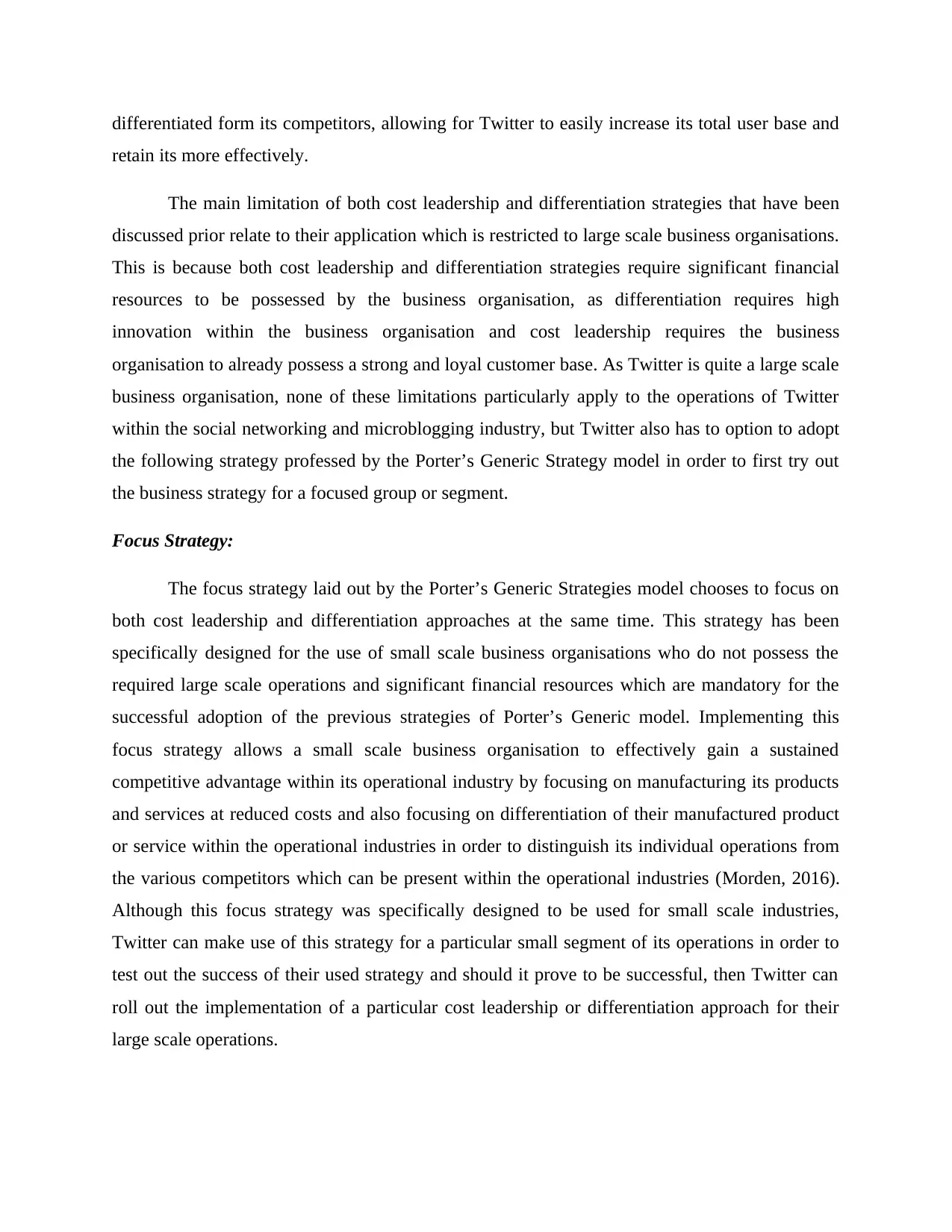
differentiated form its competitors, allowing for Twitter to easily increase its total user base and
retain its more effectively.
The main limitation of both cost leadership and differentiation strategies that have been
discussed prior relate to their application which is restricted to large scale business organisations.
This is because both cost leadership and differentiation strategies require significant financial
resources to be possessed by the business organisation, as differentiation requires high
innovation within the business organisation and cost leadership requires the business
organisation to already possess a strong and loyal customer base. As Twitter is quite a large scale
business organisation, none of these limitations particularly apply to the operations of Twitter
within the social networking and microblogging industry, but Twitter also has to option to adopt
the following strategy professed by the Porter’s Generic Strategy model in order to first try out
the business strategy for a focused group or segment.
Focus Strategy:
The focus strategy laid out by the Porter’s Generic Strategies model chooses to focus on
both cost leadership and differentiation approaches at the same time. This strategy has been
specifically designed for the use of small scale business organisations who do not possess the
required large scale operations and significant financial resources which are mandatory for the
successful adoption of the previous strategies of Porter’s Generic model. Implementing this
focus strategy allows a small scale business organisation to effectively gain a sustained
competitive advantage within its operational industry by focusing on manufacturing its products
and services at reduced costs and also focusing on differentiation of their manufactured product
or service within the operational industries in order to distinguish its individual operations from
the various competitors which can be present within the operational industries (Morden, 2016).
Although this focus strategy was specifically designed to be used for small scale industries,
Twitter can make use of this strategy for a particular small segment of its operations in order to
test out the success of their used strategy and should it prove to be successful, then Twitter can
roll out the implementation of a particular cost leadership or differentiation approach for their
large scale operations.
retain its more effectively.
The main limitation of both cost leadership and differentiation strategies that have been
discussed prior relate to their application which is restricted to large scale business organisations.
This is because both cost leadership and differentiation strategies require significant financial
resources to be possessed by the business organisation, as differentiation requires high
innovation within the business organisation and cost leadership requires the business
organisation to already possess a strong and loyal customer base. As Twitter is quite a large scale
business organisation, none of these limitations particularly apply to the operations of Twitter
within the social networking and microblogging industry, but Twitter also has to option to adopt
the following strategy professed by the Porter’s Generic Strategy model in order to first try out
the business strategy for a focused group or segment.
Focus Strategy:
The focus strategy laid out by the Porter’s Generic Strategies model chooses to focus on
both cost leadership and differentiation approaches at the same time. This strategy has been
specifically designed for the use of small scale business organisations who do not possess the
required large scale operations and significant financial resources which are mandatory for the
successful adoption of the previous strategies of Porter’s Generic model. Implementing this
focus strategy allows a small scale business organisation to effectively gain a sustained
competitive advantage within its operational industry by focusing on manufacturing its products
and services at reduced costs and also focusing on differentiation of their manufactured product
or service within the operational industries in order to distinguish its individual operations from
the various competitors which can be present within the operational industries (Morden, 2016).
Although this focus strategy was specifically designed to be used for small scale industries,
Twitter can make use of this strategy for a particular small segment of its operations in order to
test out the success of their used strategy and should it prove to be successful, then Twitter can
roll out the implementation of a particular cost leadership or differentiation approach for their
large scale operations.
⊘ This is a preview!⊘
Do you want full access?
Subscribe today to unlock all pages.

Trusted by 1+ million students worldwide
1 out of 16
Related Documents
Your All-in-One AI-Powered Toolkit for Academic Success.
+13062052269
info@desklib.com
Available 24*7 on WhatsApp / Email
![[object Object]](/_next/static/media/star-bottom.7253800d.svg)
Unlock your academic potential
Copyright © 2020–2025 A2Z Services. All Rights Reserved. Developed and managed by ZUCOL.





